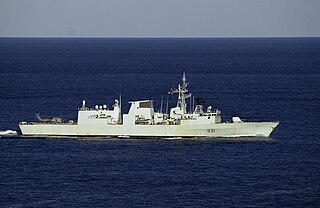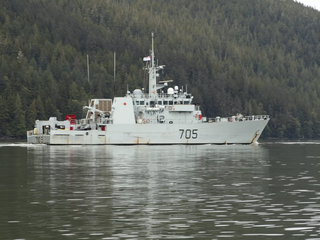
HMCS Toronto is a Halifax-class frigate that has served in the Canadian Forces since 1993. Toronto is the fourth ship in her class which is the name for the Canadian Patrol Frigate Project. She is the second RCN ship to be named for Canada's largest city. When not on operations she is assigned to Maritime Forces Atlantic (MARLANT) and is based at CFB Halifax. Toronto serves on MARLANT missions protecting Canada's sovereignty in the Atlantic Ocean and enforcing Canadian laws in its territorial sea and exclusive economic zone.

HMCS Vancouver is a Halifax-class frigate, of the Royal Canadian Navy launched on 8 July 1989, as the second vessel of her class. She is based at CFB Esquimalt on the west coast of Canada, and is the third vessel to be named after Vancouver, British Columbia.

The Kingston class consists of 12 coastal defence vessels operated by the Royal Canadian Navy. The class is the name for the Maritime Coastal Defence Vessel Project (MCDV). These multi-role vessels were built and launched from the mid- to late-1990s and are crewed by a combination of Naval Reserve and Regular Force personnel. The main mission of the vessels is to train reservists, coastal patrol, minesweeping, law enforcement, pollution surveillance and search and rescue duties. The multi-purpose nature of the vessels led to their mixed construction between commercial and naval standards. The Kingston class is split between the east and west coasts of Canada and regularly deploy overseas to West Africa, Europe, Central America and the Caribbean.

HMCS Glace Bay is a Kingston-class coastal defence vessel that has served in the Canadian Forces and Royal Canadian Navy since 1996. Glace Bay is the second ship of her class which is the name for the Maritime Coastal Defence Vessel Project. She is the second vessel to use the designation HMCS Glace Bay. She is assigned to Maritime Forces Atlantic (MARLANT) and is homeported at CFB Halifax.

HMCS Goose Bay is a Kingston-class coastal defence vessel that has served in the Canadian Forces since 1998. Goose Bay is the eighth ship of her class which is the name for the Maritime Coastal Defence Vessel Project. She is the first vessel to be named Goose Bay. The coastal defence vessel is assigned to Maritime Forces Atlantic (MARLANT) and is homeported at CFB Halifax.

HMCS Calgary is a Halifax-class frigate that has served in the Canadian Forces and Royal Canadian Navy since 1995. Calgary is the sixth vessel in her class and the second vessel to carry the designation HMCS Calgary. She was built as part of the Canadian Patrol Frigate Project. Calgary began the FELEX refit in June 2012. She is assigned to Maritime Forces Pacific (MARPAC) and is homeported at CFB Esquimalt. Calgary serves on MARPAC missions protecting Canada's sovereignty in the Pacific Ocean and enforcing Canadian laws in its territorial sea and exclusive economic zone.

HMCS Regina is a Halifax-class frigate that has served in the Canadian Forces and Royal Canadian Navy since 1993. Regina is the fifth vessel in her class which is the name for the Canadian Patrol Frigate Project. She is the second vessel to carry the designation HMCS Regina. She is assigned to Maritime Forces Pacific (MARPAC) and is homeported at CFB Esquimalt.

HMCS St. John's is a Halifax-class frigate that has served in the Canadian Forces and the Royal Canadian Navy since her commissioning in 1996. She is the eleventh of twelve ships in her class which is based on the Canadian Patrol Frigate Project. St. John's is named after the city of St. John's, Newfoundland and Labrador, a port city associated with Canadian naval history and heritage, and is the first ship in the Royal Canadian Navy to bear the name.

HMCS Winnipeg is a Halifax-class frigate that has served in the Royal Canadian Navy since 1996. Winnipeg is the ninth ship in her class, whose design emerged from the Canadian Patrol Frigate Project. She is the second Canadian warship to carry the name HMCS Winnipeg. Winnipeg serves on Canadian Forces MARPAC missions protecting Canada's sovereignty in the Pacific Ocean and the Arctic Ocean and in enforcing Canadian laws on its territorial oceans and Exclusive Economic Zone. The vessel has been deployed on missions throughout the Pacific, and also to the Indian Ocean; specifically on anti-terrorism operations in the Persian Gulf and the Arabian Sea, and counter-piracy operations off the coast of Somalia. The ship is assigned to the Maritime Forces Pacific (MARPAC), and she has her home port at the Canadian Forces Maritime Base at Esquimalt.

HMCS Brandon is a Kingston-class coastal defence vessel that has served in the Canadian Forces since 1999. Brandon is the eleventh ship of her class. She is the second vessel to use the name HMCS Brandon. The Brandon is assigned to Maritime Forces Pacific (MARPAC) and is homeported at CFB Esquimalt.

HMCS Kingston is a Kingston-class coastal defence vessel that has served in the Canadian Forces since 1996. Kingston is the lead ship of her class, ordered under the Maritime Coastal Defence Vessel Project. She is the first vessel to use the designation HMCS Kingston. She is assigned to Maritime Forces Atlantic (MARLANT) and is homeported at CFB Halifax.

HMCS Moncton is a Kingston-class coastal defence vessel that has served in the Canadian Forces since 1998. Moncton is the ninth ship of her class. She is the second vessel to use the designation HMCS Moncton. The ship is assigned to Maritime Forces Atlantic (MARLANT) and is homeported at CFB Halifax.

HMCS Nanaimo is a Kingston-class coastal defence vessel that has served in the Canadian Forces and Royal Canadian Navy since 1997. Nanaimo is the third ship of her class. She is the second vessel to use the designation HMCS Nanaimo. She is assigned to Joint Task Force Pacific and is homeported at CFB Esquimalt.

HMCS Saskatoon is a Kingston-class coastal defence vessel delivered to the Canadian Forces in 1998. Saskatoon is the tenth ship of her class and is the second vessel to use the designation HMCS Saskatoon. Named after the Canadian city of Saskatoon, Saskatchewan, other references to the city are found on the ship with the ships captains desk named Cranberry Flats and a main corridor in the ship named after Idylwyld Drive. Saskatoon is assigned to Maritime Forces Pacific (MARPAC) of the Royal Canadian Navy and is homeported at Canadian Forces Base (CFB) Esquimalt.

HMCS Shawinigan is a Kingston-class coastal defence vessel that has served in the Canadian Forces and the Royal Canadian Navy since 1997. Shawinigan is the fifth ship of her class. She is the second vessel to use the designation HMCS Shawinigan. The ship is assigned to Maritime Forces Atlantic (MARLANT) and is homeported at CFB Halifax.

HMCS Summerside is a Kingston-class coastal defence vessel of the Royal Canadian Navy that has served in the Canadian Forces since 1999. Summerside is the twelfth, and last, ship of her class. She is the second vessel to use the designation HMCS Summerside. She is assigned to Maritime Forces Atlantic (MARLANT) and is homeported at CFB Halifax.

HMCS Whitehorse is a Kingston-class coastal defence vessel that has served in the Canadian Forces since 1998. Whitehorse is the sixth ship of her class. The first vessel named for the city in the Yukon, the ship is assigned to Maritime Forces Pacific (MARPAC) and is homeported at CFB Esquimalt.

HMCS Yellowknife is a Kingston-class coastal defence vessel that has served in the Canadian Forces since 1998. Yellowknife is the seventh ship of her class. She is the first vessel to use the designation Yellowknife in the Royal Canadian Navy. The coastal defence vessel is assigned to Maritime Forces Pacific (MARPAC) and is homeported at CFB Esquimalt.
Operation Caribbe is the Canadian Armed Forces contribution to the elimination of illegal trafficking in the Caribbean Sea and the eastern Pacific Ocean by organized crime. The operation began in 2006 and its mandate has been altered twice since then.

HMCS Harry DeWolf is the lead ship of its class of offshore patrol vessels for the Royal Canadian Navy (RCN). The class was derived from the Arctic Offshore Patrol Ship project as part of the National Shipbuilding Procurement Strategy and is primarily designed for the patrol and support of Canada's Arctic regions. Named after Vice Admiral Harry DeWolf, a former head of the RCN, the vessel was ordered in 2011, laid down in 2016 and launched in 2018. The vessel completed contractors sea trials in July 2020, was delivered to the RCN on 31 July 2020 and began post-acceptance sea trials. Harry DeWolf was commissioned on 26 June 2021.



















